
28 Sep In a Bind: The 90 Day Cast
By Gita Wolf and Joëlle Jolivet
This fantastic book was never thought of as a book, to begin with. It came together—literally—by accident.
But to begin at the beginning: we had known the wonderful French illustrator Joëlle Jolivet for several years, and finally had the chance to work with her in 2014. Joëlle came to visit us in Chennai that year, and we spent happy times together at our local beach, as she worked on an unusual children’s book called An Indian Beach.

Joëlle at the beach, Chennai
We knew there was lots more we wanted to create together, and the idea was for Joëlle to come back in the not-too-distant future and spend more time with us as an artist in residence, to come up with more projects. The chance came in January 2017, when the Alliance Francaise de Madras agreed to support her travel, and we were all looking forward to it.
Then, a few days before she was due to set out, we received a shocking email from Joëlle’s husband—to say that she had fallen down the cellar stairs in their house, and had broken her neck! We were horrified, and thankful that she had survived—there was nothing we could do except wish her well, and hope that she would recover soon. Naturally, all our plans were shelved. We stayed sporadically in touch with her husband, to hear how she was faring. Not badly under the circumstances, we were told. Our thoughts continued to be with her and one day, looking for news of Joëlle, one of us chanced upon her Facebook page—to discover something incredibly poignant: even in her broken condition, Joëlle’s spirit was indomitable.
Every single day, she would post a drawing of herself in her incapacitated state. There was no self-pity in these portraits—they were honest in their depiction of pain, yet incredibly clever, full of wit and whimsy. We were amazed, and began to follow her progress through these drawings. It dawned on us that we were witness to the resilience of a remarkably creative human spirit, drawing on the expressive and healing power of art—day by day, in real time. It was quite an experience, and we were reminded of other artists, like Frida Kahlo, who had turned their suffering into creativity that resonated universally.
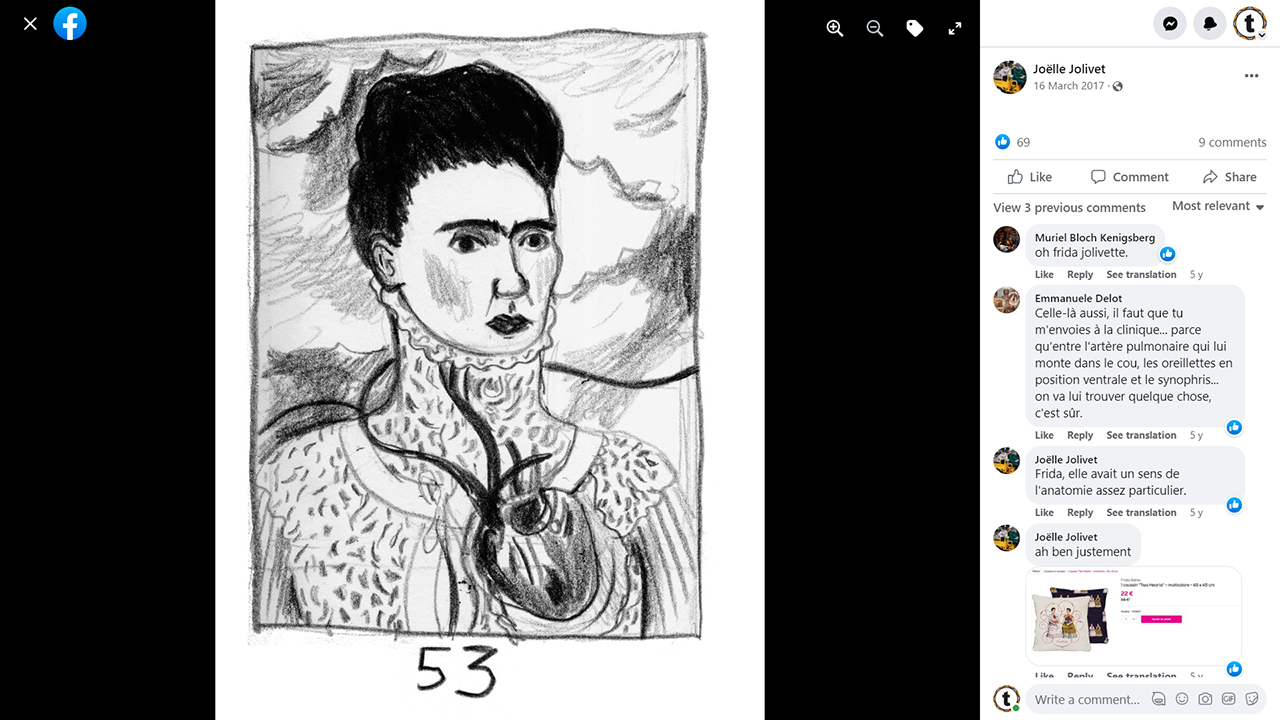
Frida on Facebook: from Joëlle’s original posts
As time went on and Joëlle recovered, we sensed a book there, but it was still too early to bring this up with her. We needed to wait for the healing to be complete, and to find the right time to broach this to her, preferably in person.
Then, in 2018, I met her at the Bologna Book Fair and hesitantly put our idea forward. Joëlle laughed, in her down-to-earth way, saying that only Tara would think of something as weird as this book. But she was on board, and happy to make it happen. She sent us the original images, and the fantastic captions that went with each one.
There were only a couple of editorial suggestions from our end, to make the book resonate with readers across the world. One was the need to annotate her allusions for non-French readers, who might not get all the European references to film, literature and popular culture. We wanted to do this subtly, without changing her original inspiration—so with her help, we created an index at the end of the book, which didn’t interfere with the reading.
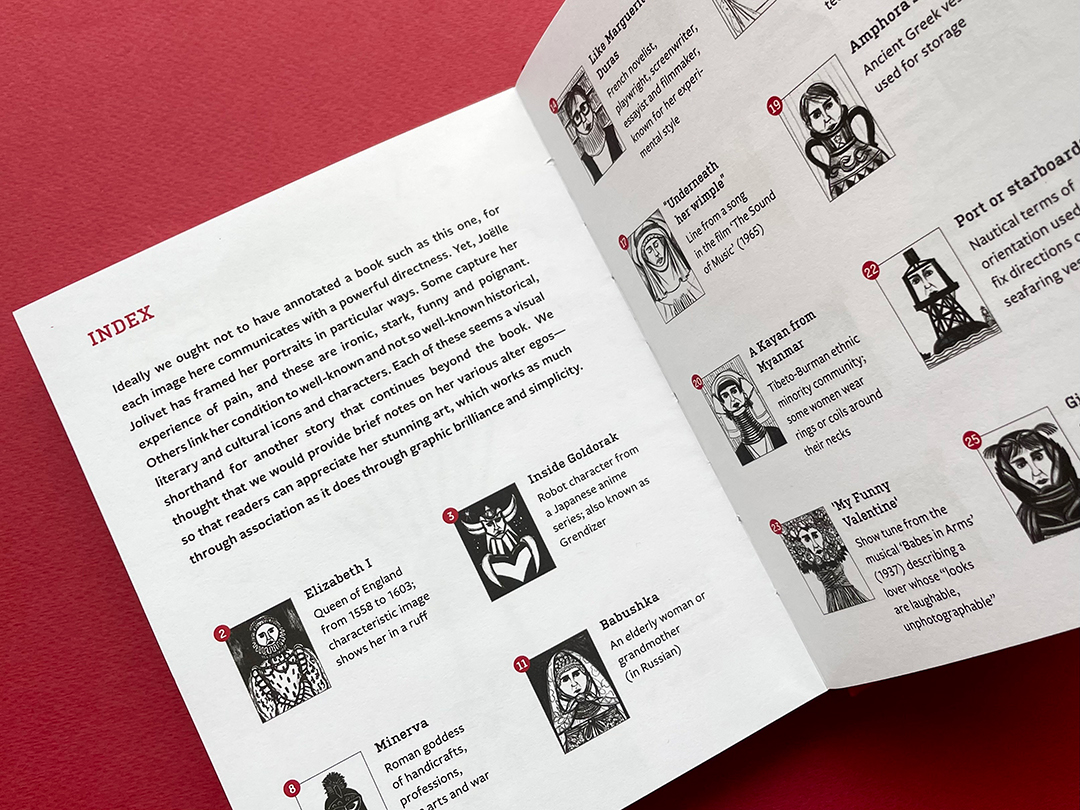
Annotating Joëlle’s illustrations
The second editorial input—if the book was to work as a book—was to have a prequel to the visual diary, which would set the situation in a context. Joëlle loves the comic book form, so we agreed on an introductory strip which would show the reader how she landed up in a cast in the first place.
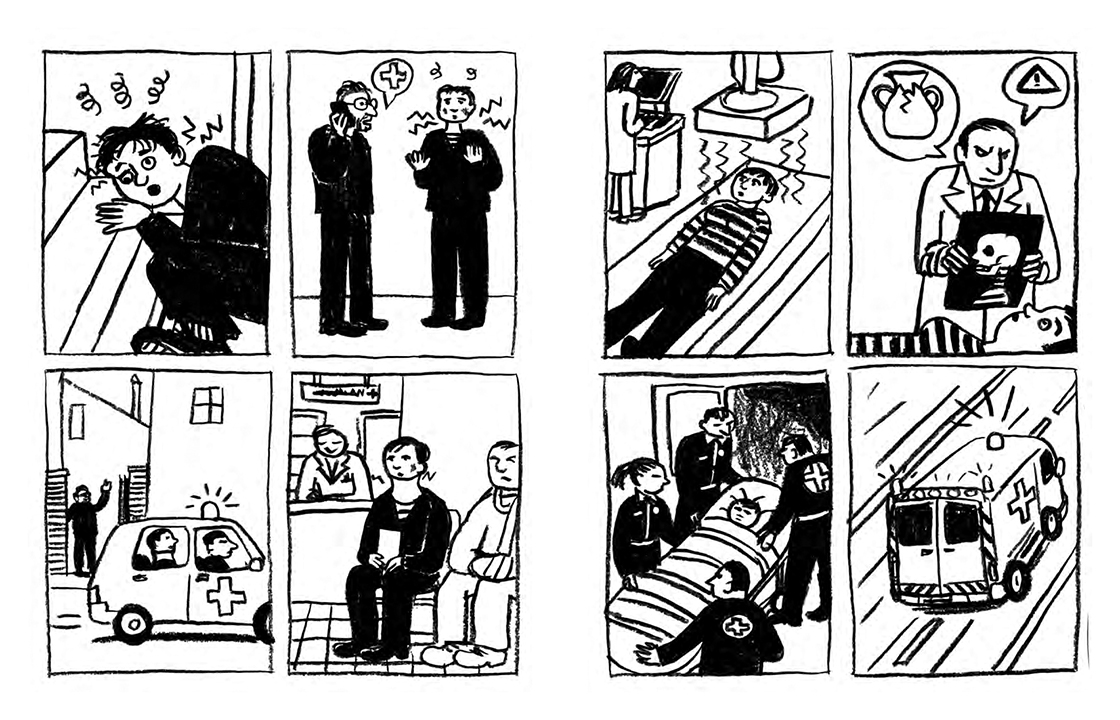
A comic for context
Which of course led us to the delicious selection of a title, punning on the word ‘cast’—and the numerous characters that Joëlle had cast herself as, drawing from art, literature and other creative people. A play on words, images and allusions, so to speak.
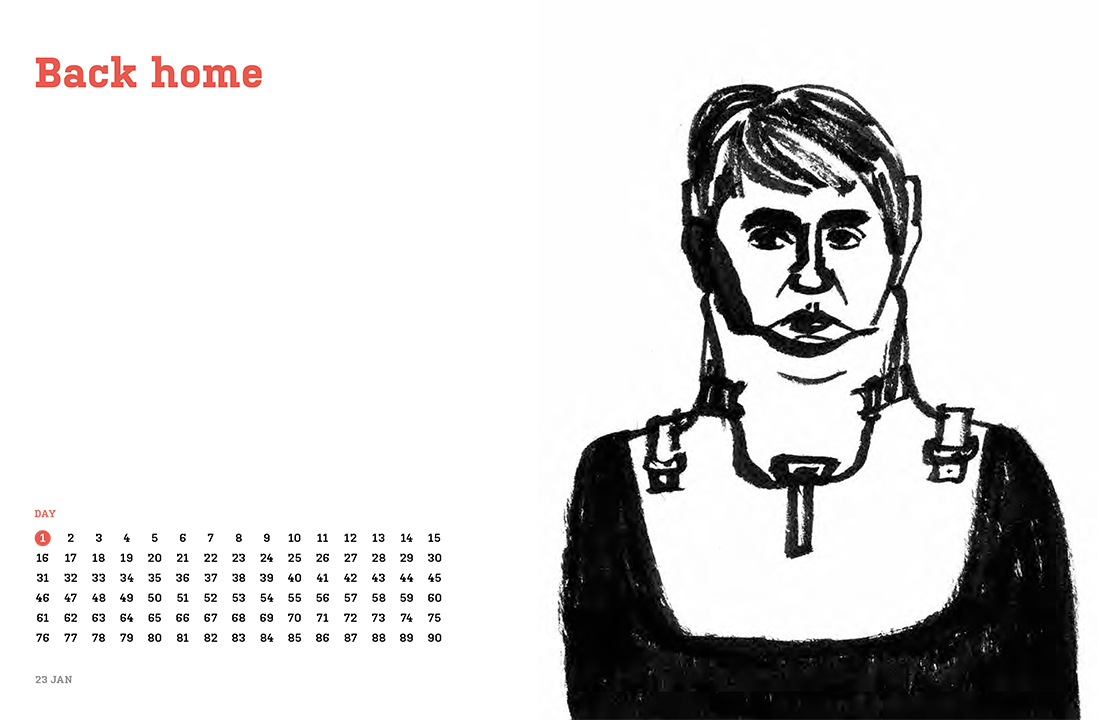
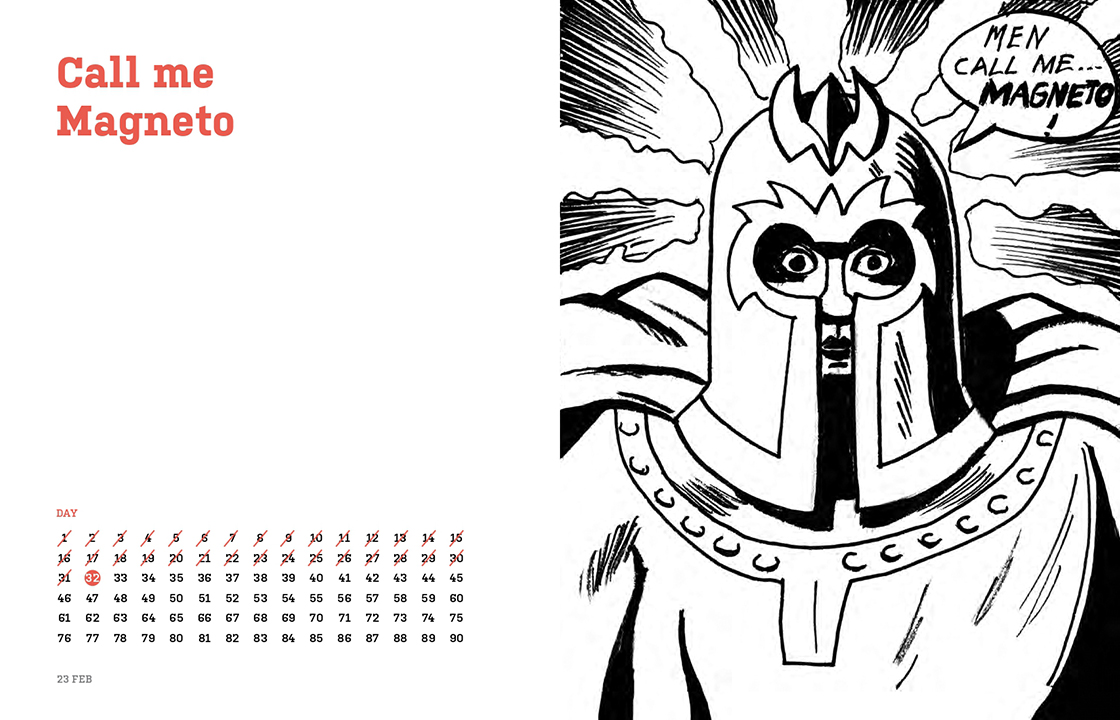
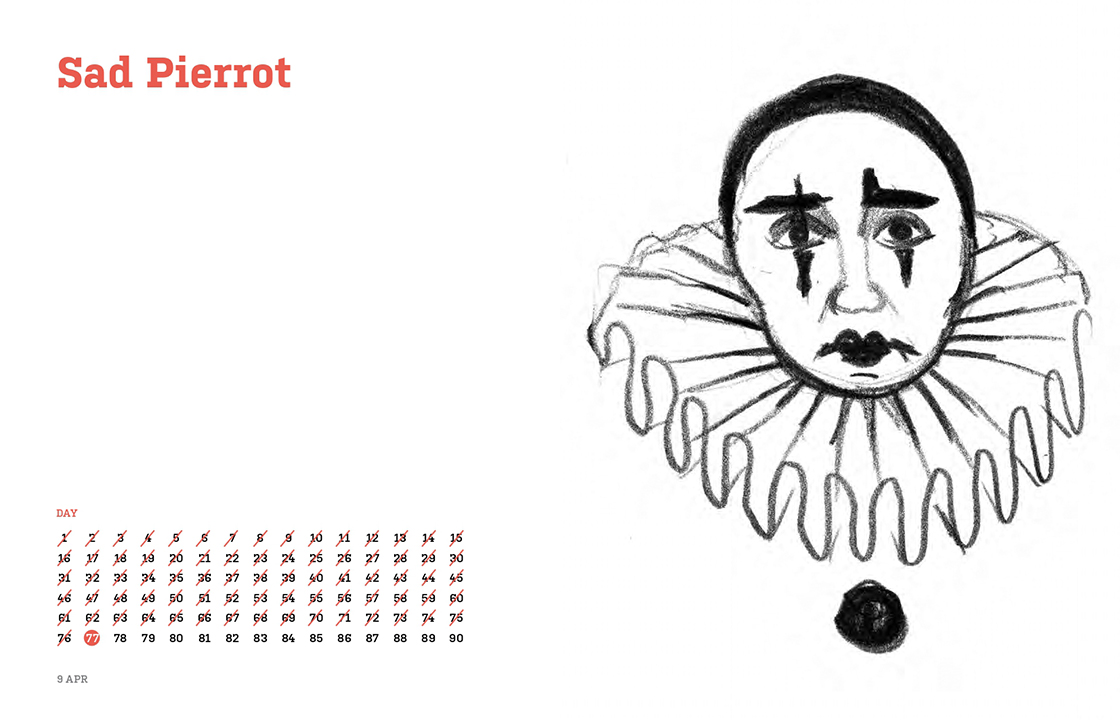
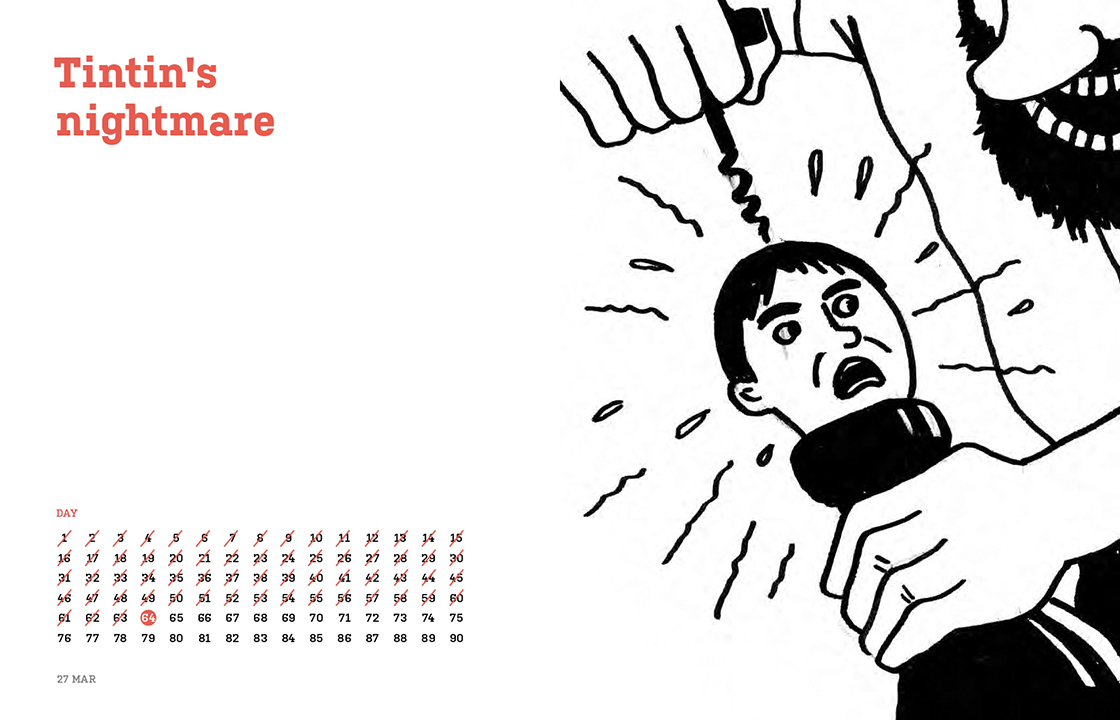
Spreads from the book
After some thought, we settled on a straightforward design that treated the flow of images as a calendar keeping track of a personal journey, taking the reader through the ninety days that Joëlle found herself trapped in a cast. The cover of the book was to be screen-printed, on red handmade paper, to resonate with the feel of a diary.

The cover for The 90 Day Cast, silkscreen-printed on handmade paper
Meanwhile, the pandemic intervened, and the project, like many others, was stalled. But the experience of being ill, trapped or isolated now took on a new meaning that we could all identify with more closely. In this sense, finally bringing out this book now has expanded the sense of what it means to hold on and pull through illness and hard times—and, in the process, not only keep a sense of dark humour alive, but also create art that will endure. This has been our sense of what the book means, and we’re delighted to be able to bring it out into the world at last. To complete the picture, we decided to ask Joëlle about her perspective on the process of creation:
What prompted you to begin this series of portraits?
JJ: When I came back from the hospital, I just drew a self-portrait… maybe to make sure that I was still alive? And able to draw… The first drawing was on a blank dummy book of 96 pages that I had (you know, the sample sent by a printer to show what a book will look like, a book with white pages). So then I decided to draw one self-portrait a day, and to fill the book.
Ah, so it was in a book to begin with! What was your process for each day? Did you have a routine?
JJ: I think I drew one portrait every morning, before working on anything else (I was hardly working on anything else anyway, but I did draw something every day, on a reclining table). I posted the portraits on Facebook (I was not on instagram at that time).
Did the ideas for each portrait come to you straightaway or were there some that needed more time?
JJ: It was very spontaneous, connected with the feeling of the day. And I had plenty of time to find ideas for the next day…
Is this project different from your other work? Or is there something it has in common with your other illustrations?
JJ: For me, they were just sketches, exercises…my initial idea was to explore different styles of drawing, in a formal search, using freer, changing tools. But the paper and the size of my book weren’t good enough, so I did it in a more classic way. I didn’t plan to make a book with these sketches… and I was very surprised when Gita asked me to do it! The drawings were a personal challenge, and I simply posted them on Facebook. The first reason was to make sure I did it every day, and the second was to keep in touch with people…
How did you feel at the end of the ninety days?
JJ: Well… relieved! But it took a lot more time for my neck to recover its flexibility. I have to add that when the accident happened, we met the best neurosurgeon, who decided not to operate on me immediately, but to wait and watch… so I waited, confined for ninety days in my cast… and I did recover. In any case, if he had operated on me, I would still have had to spend ninety days in a cast afterwards… So all in all, I’m very grateful to him!
Gita Wolf started Tara Books, as an independent publishing house based in India. An original and creative voice in contemporary Indian publishing, Gita Wolf is known for her interest in exploring and experimenting with the form of the book and has written and over twenty books for children and adults. Several have won major international awards and been translated into multiple languages. Click here to discover Tara books she has authored.
Joëlle Jolivet is one of the best known illustrators in France. Born in 1965, she studied Graphic Art and Advertising at School of Applied Arts in Paris. Joelle was always interested in engraving and printing, so she spent a year in the lithography workshop at the Beaux Arts. This led her to the discipline of lino-cutting, which has remained her main mode of expression ever since. Click here to discover her other Tara books.



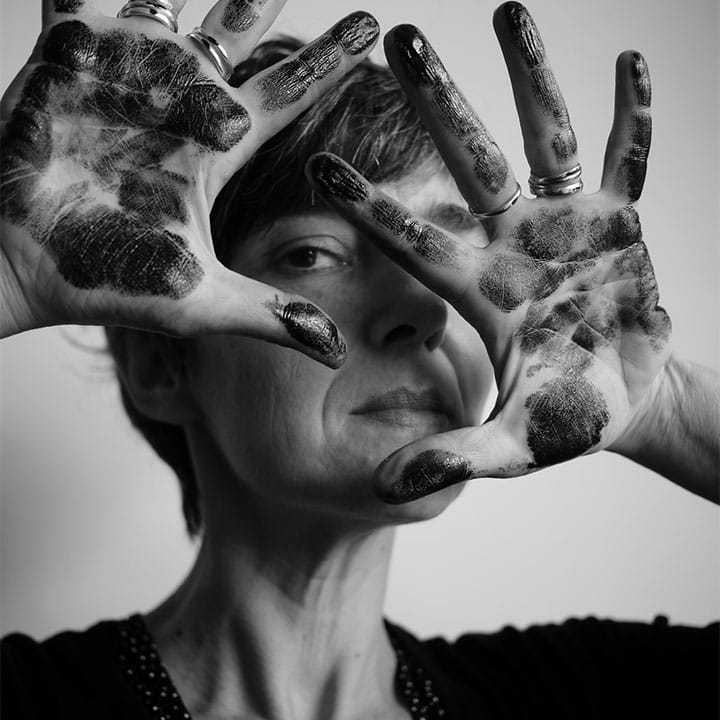
Anbazhagan Sam Venkatesan
Posted at 11:34h, 17 AprilOnce I get into the website, i linger around for so long! Oh! What a world of creative and compassionate work!